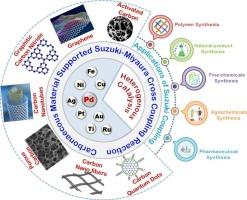探索碳基材料作为铃木-宫浦偶联反应的定制平台:综述
IF 20.3
1区 化学
Q1 CHEMISTRY, INORGANIC & NUCLEAR
引用次数: 0
摘要
活性炭、石墨烯、氮化石墨碳、碳纳米管、碳纳米纤维和其他碳质衍生物等碳基材料具有大表面积、定制表面功能性和高化学稳定性等优异特性,因此被认为是一种前景广阔的催化剂固定化策略。在铃木偶联反应中使用它们作为催化剂载体,对提高催化耐久性、可重复使用性和反应选择性做出了重大贡献。虽然铃木宫浦偶联反应是一种成熟的工业工艺,但目前学术界正在开展大量研究,以扩大底物范围,开发更高效的催化剂,提高其实用性。本综述全面分析了 2015-2023 年间碳基材料作为催化剂载体在铃木偶联反应中的应用。文中讨论了用于生产碳基载体的合成方法以及将铃木偶联催化剂固定在载体上的过程,深入探讨了这些材料对催化性能、反应动力学和产物产率的影响。这篇综述将为科学家和工业专业人士提供具有洞察力的信息,以帮助指导催化剂设计的未来途径,并推动开发更环保、更有效的催化过程。本文章由计算机程序翻译,如有差异,请以英文原文为准。

Exploring Carbon-based Materials as a tailored platform for Suzuki–Miyaura Coupling Reaction: A Review
Carbon-based materials, such as activated carbon, graphene, graphitic carbon nitride, carbon nanotubes, carbon nanofibers, and other carbonaceous derivatives, are being considered as a promising strategy for catalyst immobilization because of their exceptional characteristics, such as large surface area, tailored surface functionalities, and high chemical stability. Their use as catalyst support in Suzuki coupling reactions has made a significant contribution to enhancing catalytic durability, reusability, and reaction selectivity. Although the Suzuki Miyaura coupling reaction is an industrial established process, but significant research in academia is currently being conducted to enhance the substrate scope, developing more efficient catalysts, and improve its practicality. This review provides a thorough analysis of the application of carbon-based materials as catalyst supports in Suzuki coupling reactions between the years 2015–2023. The synthesis methodologies used to produce carbon-based support and the processes involved in the immobilization of Suzuki coupling catalysts onto the supports have been discussed, providing insight into the influence of these materials on catalytic performance, reaction kinetics, and product yields. This review will provide insightful information to scientists and industry professionals to assist in directing future avenues for catalyst design and advance the development of more environmentally friendly and effective catalytic processes.
求助全文
通过发布文献求助,成功后即可免费获取论文全文。
去求助
来源期刊

Coordination Chemistry Reviews
化学-无机化学与核化学
CiteScore
34.30
自引率
5.30%
发文量
457
审稿时长
54 days
期刊介绍:
Coordination Chemistry Reviews offers rapid publication of review articles on current and significant topics in coordination chemistry, encompassing organometallic, supramolecular, theoretical, and bioinorganic chemistry. It also covers catalysis, materials chemistry, and metal-organic frameworks from a coordination chemistry perspective. Reviews summarize recent developments or discuss specific techniques, welcoming contributions from both established and emerging researchers.
The journal releases special issues on timely subjects, including those featuring contributions from specific regions or conferences. Occasional full-length book articles are also featured. Additionally, special volumes cover annual reviews of main group chemistry, transition metal group chemistry, and organometallic chemistry. These comprehensive reviews are vital resources for those engaged in coordination chemistry, further establishing Coordination Chemistry Reviews as a hub for insightful surveys in inorganic and physical inorganic chemistry.
 求助内容:
求助内容: 应助结果提醒方式:
应助结果提醒方式:


